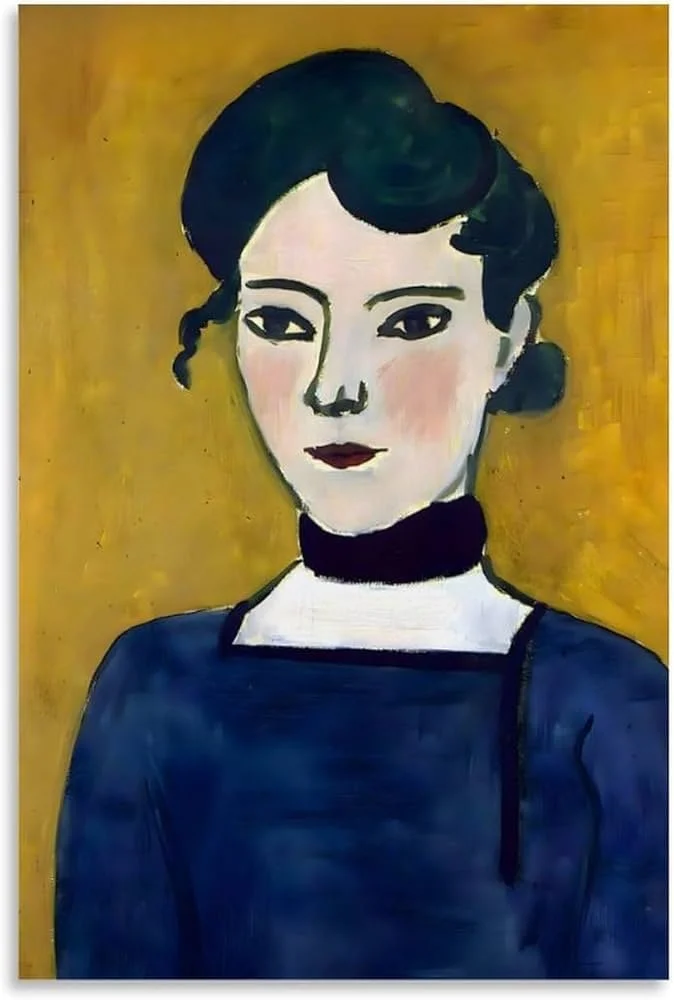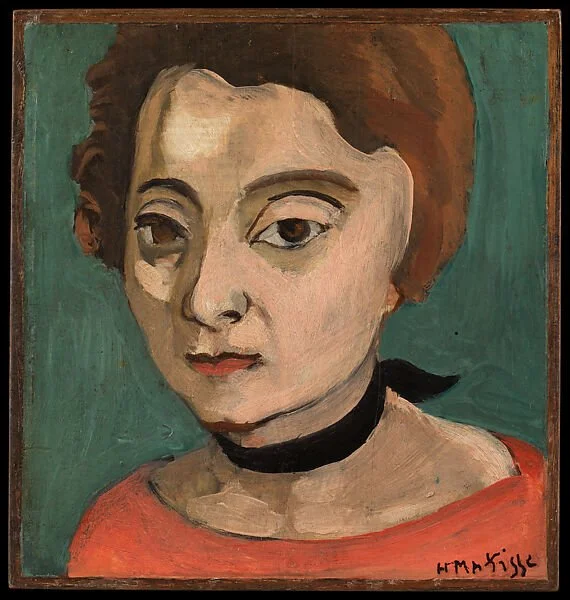MARGUERITE MATISSE: A Daughter's Courage in Occupied France
Among Matisse's three children was his eldest daughter, Marguerite Matisse-Duthuit, born in 1894.1 While often recognized as a frequent model in her father's paintings, her story extends far beyond the canvas. Marguerite played a significant, and often perilous, role in the French Resistance during World War II, demonstrating remarkable bravery and resilience in the face of Nazi oppression.
Matisse with his wife Amelie and his daughter Marguerite
Marguerite Emilienne Matisse was born in Paris on August 31, 1894, the daughter of Henri Matisse and Caroline Joblau, one of his models.2 She was legally recognized by her father and raised alongside his two sons with his wife Amélie Parayre: Jean, born in 1899, and Pierre, born in 1900.2 Despite the circumstances of her birth, the family maintained a close bond.25 Marguerite's early life was marked by health challenges. At the age of six, she contracted diphtheria, necessitating an emergency tracheotomy.17 The resulting scar on her neck became a distinctive feature, often concealed by a ribbon or high-necked clothing in the numerous portraits her father painted of her.17
Growing up in the household of a renowned artist, Marguerite became deeply involved in her father's creative world. She served as his most consistent model over several decades, from her childhood to adulthood.20 Their relationship extended beyond that of artist and muse; Marguerite offered her father candid and insightful critiques of his work, suggesting a significant level of intellectual engagement and mutual respect.17 She played a practical role in managing his studio affairs and acting as a point of contact with art collectors.21
As World War II engulfed Europe and France fell under Nazi occupation, Marguerite Matisse actively resisted the oppressive regime. This commitment to resistance was shared by other members of her family. Her stepmother, Amélie, and her half-brother, Pierre, were also involved in efforts against the German occupiers.3 Amélie worked as a typist for an underground publication, while Pierre, who had moved to New York, helped Jewish artists escape occupied France.20
Marguerite became an active member of the clandestine Front National, a significant resistance organization with communist affiliations.3 She was also involved with the Francs Tireurs et Partisans Français (FTPF), a resistance group linked to the French Communist Party.3 Marguerite's affiliation with these specific groups indicates a potential alignment with left-leaning political ideologies that were strongly opposed to fascism and the Nazi occupation. Understanding the political leanings and operational methods of the Front National and the FTPF provides a clearer picture of the type of resistance work Marguerite was likely engaged in, suggesting activities that went beyond simple opposition and involved organized efforts to undermine the occupying forces.
Within the framework of the French Resistance, Marguerite took on the crucial and perilous role of a courier, tasked with carrying messages for the underground network.3 This role, while often less visible than armed combat, was absolutely vital for the functioning of the Resistance, enabling communication and coordination between different cells and operatives. Couriers like Marguerite played a critical part in disseminating information, relaying instructions, and maintaining the clandestine network that sought to undermine the Nazi occupation.
Sources specifically mention her assisting as a courier while her stepmother Amélie worked on the production of an underground publication.20 The work of a courier was fraught with danger. Those involved faced the constant threat of detection by the Gestapo, the Nazi secret police, which could lead to immediate arrest, brutal torture, and even death. The necessity for absolute secrecy and the ever-present risk of exposure would have placed immense psychological strain on Marguerite, requiring her to maintain unwavering composure and vigilance in the face of extreme pressure.
Marguerite Matisse Duthuit and her brother Pierre Matisse stand in front of a painting by their father in 1970, at an exhibition in the Grand Palais in Paris.
In April 1944, Marguerite's was captured by the Gestapo in Rennes, a city in the Brittany region of France.3 Around the same time, her stepmother, Amélie, was also apprehended by the Gestapo.3 Following her capture, Marguerite was imprisoned in Rennes.20 The fact that both Marguerite and Amélie were arrested in close proximity suggests a potential connection in their resistance work. It is possible they were operating within the same network or that a broader Gestapo crackdown in the Rennes area led to their simultaneous apprehension.
After her capture in Rennes, Marguerite endured brutal interrogation and torture at the hands of the Gestapo.3 Multiple sources corroborate this horrific aspect of her experience, with some emphasizing the severity of her ordeal. She was described as having been "tortured and disfigured" 3, "tortured (almost to death)" 14, and "tortured near fatally".20 Following her escape, Marguerite recounted her experiences to her father, leaving a profound impression on him.
Following her torture, Marguerite was slated for deportation to the Ravensbrück concentration camp, a notorious women-only camp located in Germany.13 The train carrying Marguerite was brought to a halt by an Allied Forces air raid.20 She escaped Nazi custody3 and sought refuge by hiding in the nearby woods.20 She was later discovered and rescued by fellow members of the French Resistance, who provided her with aid and shelter.20
A few months after her harrowing escape, in 1945, Marguerite was reunited with her father, Henri Matisse.3 The reunion was deeply emotional for Matisse, who was profoundly moved by his daughter's story and the visible scars of her ordeal.3 The trauma of her capture, torture, and near-death experience undoubtedly left a lasting impact on Marguerite's physical and psychological well-being. Despite the suffering she endured, Matisse portrayed her in his subsequent portraits as a figure of strength and resilience.3 One account notes that in the portraits he created in 1945, Marguerite bore the look of a woman who had experienced immense hardship 21, while another suggests that her ordeal had prematurely aged her.24
In 1923, before the war, Marguerite had married Georges Duthuit, a writer and art critic.1 Following the war, she dedicated a significant portion of her life to preserving her father's artistic legacy. She collaborated with scholars and students of his work and undertook the monumental task of cataloging his extensive oeuvre.20 Marguerite was present at her father's side when he passed away in 1954.20 She continued her work on the catalog raisonné until her own death from a heart attack in 1982.
Works cited
1. The Matisse Family Tree - STAIR Galleries, accessed April 25, 2025, https://www.stairgalleries.com/discover-news/discover/10_17_22/
2. Henri Matisse - Wikipedia, accessed April 25, 2025, https://en.wikipedia.org/wiki/Henri_Matisse
3. 10 Things to Know About Henri Matisse - Artsper Magazine, accessed April 25, 2025,
https://blog.artsper.com/en/a-closer-look/10-things-to-know-about-henri-matiss e/
4. Henri Matisse 1869–1954 - Tate, accessed April 25, 2025, https://www.tate.org.uk/art/artists/henri-matisse-1593
5. Henri Matisse | Biography, Art Style, Paintings, Prints, & Collage | Britannica, accessed April 25, 2025, https://www.britannica.com/biography/Henri-Matisse
6. Henri Matisse Biography - Masterworks Fine Art Gallery, accessed April 25, 2025, https://www.masterworksfineart.com/artists/henri-matisse/biography
7. Henri Matisse | The Guggenheim Museums and Foundation, accessed April 25, 2025, https://www.guggenheim.org/artwork/artist/henri-matisse
8. Henri Matisse, accessed April 25, 2025, https://www.henrimatisse.org/
9. Henri Matisse - Paintings, Artworks & Facts - Biography, accessed April 25, 2025, https://www.biography.com/artists/henri-matisse
10. Henri Matisse - Art History and Artists - Ducksters, accessed April 25, 2025, https://www.ducksters.com/biography/artists/henri_matisse.php
11. Henri Matisse: Life, Legacy and Love of Southern France - - French Side Travel, accessed April 25, 2025,
https://frenchsidetravel.com/henri-matisse-southern-france/
12. Henri Matisse (1869–1954) - The Metropolitan Museum of Art, accessed April 25, 2025, https://www.metmuseum.org/essays/henri-matisse-1869-1954
13. All About Henri Matisse: Famous French Artists Series – My Private ..., accessed April 25, 2025, https://myprivateparis.com/all-about-henri-matisse/
14. Tête de femme (Head of a Woman) - Childs Gallery, accessed April 25, 2025, https://childsgallery.com/work/tete-de-femme-head-of-a-woman/
15. artnet Magazine - Matisse and the Nationalism of Vichy, 1940-1944, accessed April 25, 2025, http://www.artnet.com/magazineus/books/cone/cone12-19-05.asp
16. The Painter's Family, 1911 by Henri Matisse, accessed April 25, 2025, https://www.henrimatisse.org/the-painters-family.jsp
17. Matisse's Women: Four female muses who shaped the master | theluvvie, accessed April 25, 2025,
https://theluvvie.com/2016/09/04/matisses-women-four-female-muses-who-sha ped-the-master/
18. Blog tour: Madame Matisse by Sophie Haydock - Dr Alice Violett, accessed April 25, 2025, https://www.draliceviolett.com/blog-tour-madame-matisse
19. French Resistance | - castlesandcoffeehouses.com, accessed April 25, 2025,
Written with the help of AI





